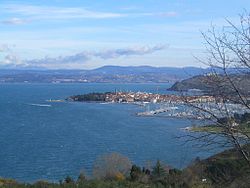Izola
|
Izola Isola |
|||
|
|||
| Basic data | |||
|---|---|---|---|
| Country |
|
||
| Historic region | Coastal land / Primorska | ||
| Statistical region | Obalno-kraška (coast and karst) | ||
| Coordinates | 45 ° 32 ' N , 13 ° 39' E | ||
| surface | 28.6 km² | ||
| Residents | 15,922 (2008) | ||
| Population density | 557 inhabitants per km² | ||
| Post Code | 6310 | ||
| License Plate | KP | ||
| Boat registration | IZ | ||
| Structure and administration | |||
| Website | |||
Izola ( Italian Isola , German obsolete: island in the coastal region ) is a city on the Adriatic coast of Slovenia , in the Primorska region (coastal region).
population
The vast majority of the population (69.1%) said Slovene was their mother tongue in the 2002 census . The most important minority languages are Croatian (8.2%) and Italian (4.3%).
Italian is a recognized minority language in Izola with special protection under Article 64 of the Slovenian Constitution. Before the Second World War, there was a predominantly Italian-speaking population in the area of today's municipality of Izola (then Isola ) who fled or was expelled in 1945/1954.
history
The old town is located on the former island to which the name of the city can be traced back. The proximity of the island to the mainland led to settlement in the first century. The island was later connected to the mainland by the construction of a stone bridge. In 1253, Izola declared its independence with its own legislation and government. In the 13th and 14th centuries this led to city wars with the rival cities of Koper and Piran .
The cartographer Pietro Coppo came to Izola in 1499 and has written several well-known works and drawn maps. One of his last works was 'Del sito de Listria' Become a carved in stone reproduction of his card from the Istria in Pietro Coppo Park is located in the center of Izola.
From the 13th century, Izola belonged to the Republic of Venice . Pasquale Besenghi degli Ughi had the stately and most magnificent building, the Besenghi Palace, built in 1775. He came from a Venetian family and inherited the extensive library from his father, which still contains around 3000 books and some manuscripts from the 16th and 17th centuries.
In 1797 the Habsburgs came to power, and Izola was part of the Habsburg monarchy and was incorporated into the Crown Land Coastal Land. At the beginning of the 19th century, the city wall was torn down in order to fill the sea between the island and the mainland with the demolition material. During this time, mineral spring researcher and Minorit Chiaro Vascotto discovered a mineral spring in Izola in 1820. Then he arranged for the St. Peter's thermal baths to be built with the help of some wealthy townspeople. The mineral bath was opened in 1824 with a hall for dance and music events. Vascotti owe the beginnings of tourism in Izola, so to speak. The bath later became a fish processing plant, on whose premises the spring is located (Fabbrica Arrigoni, today the Delamaris factory).
Towards the end of the 19th century, Izola was a flourishing town, as the following entry in Meyer's Konversationslexikon proves: " Isola , market town in the Austro- Illyrian coastal region (Istria), Capo d'Istria district administration , on a rock protruding into the sea, with a customs office , excellent viticulture , sulfur bath, harbor and (1880) 5580 inhabitants. "
According to the KuK censuses , there were 5,326 Italians, 20 Slovenes and 17 Germans living in Isola / Izola in 1900.
In 1918 Izola fell with most of the coastal land to Italy, in 1947 to the Free Territory of Trieste ( Zone B ), when it was dissolved in 1954 to the Yugoslav republic of Slovenia.
Even today one can recognize the eventful history of the city from the special architecture of the old town center and the fishing tradition of the city is still partly reflected in the tourist and culinary offerings of Izola.
The Mehano company is based here.
Marina
The Marina Izola is one of several marinas in the area and is therefore important for tourism in Izola. The marina has berths for 700 boats up to a length of 30 m. The marina includes a holiday resort with a hotel, tennis courts, a swimming pool and a casino.
The marina also serves as a base for water sports events such as the Austria Cup . Some regattas in Slovenia are sailed in the sea area in front of the Marina Izola.
Attractions
- Parenzana Narrow Gauge Railway Museum and Railway Model Collection: it is one of the largest collections of model trains in the world.
Famous citizens
- Pietro Coppo
- Pasquale Besenghi
- Mayor Manzioli
- Giovanni Thamar
- Antonio Morona
- Chiaro Vascotto
- Franjo Ravnik
- Bonaventure
- Marino Contesini
- Nino Benvenuti
sons and daughters of the town
- Nino Benvenuti (* 1938), Italian boxer
- Vinicio Gerin , medal for bravery of the Italian Navy in World War II
climate
- Average temperature in summer: 28 ° C
- Average temperature in winter: 5 ° C
- Sunny days per year: 300
- Rainy days per year: 65
Web links
- Homepage of Izola (Slovenian, Italian)
- Tourist information office Izola
- Marina Izola
Individual evidence
- ↑ http://www.stat.si
- ↑ Isola . In: Meyers Konversations-Lexikon . 4th edition. Volume 9, Verlag des Bibliographisches Institut, Leipzig / Vienna 1885–1892, p. 45.
- ↑ www.marinaizola.com Information about the marina. Accessed March 10, 2014.
- ↑ The Parenzana Narrow Gauge Railway Museum and the collection of railway models , accessed on December 9, 2011.



